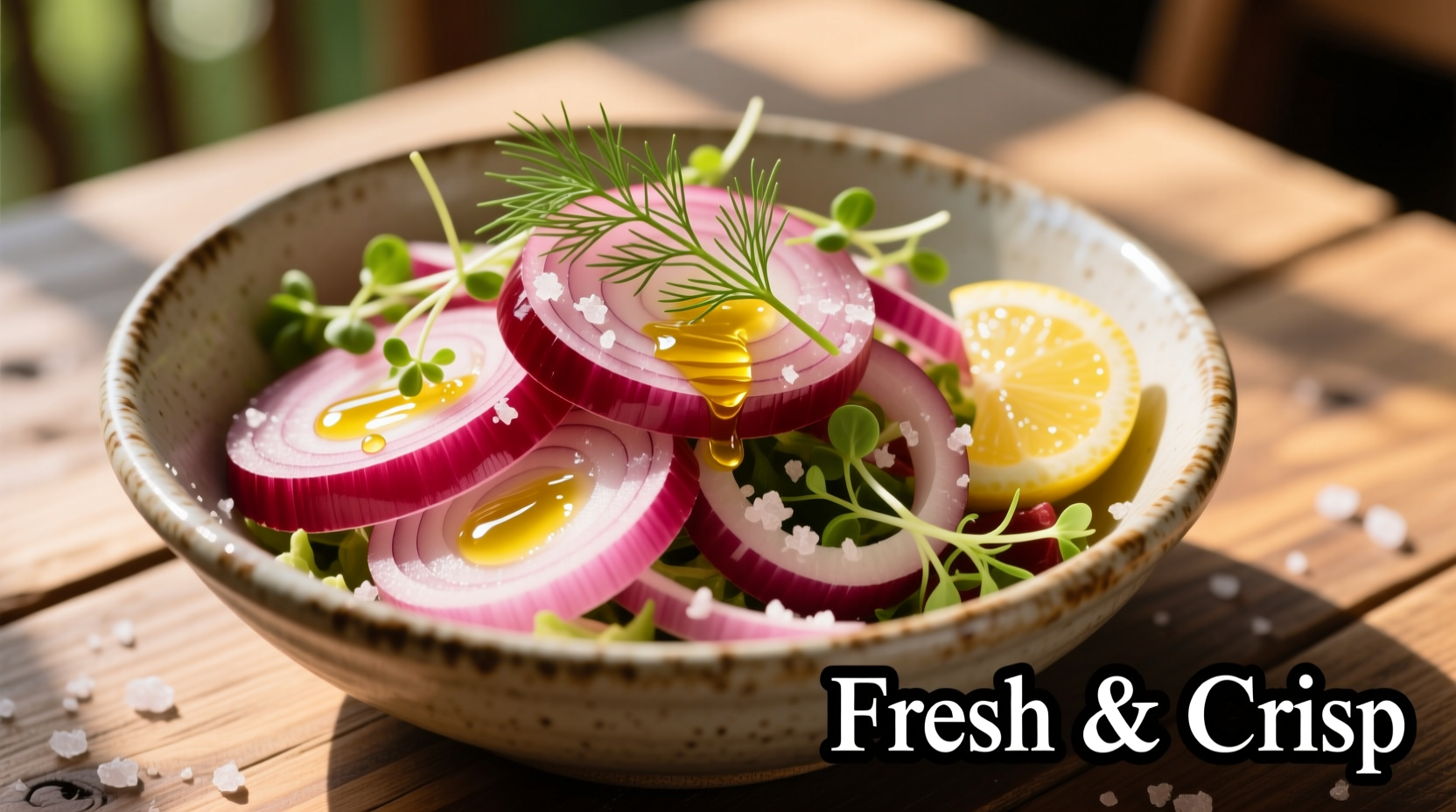Red onion salad is a versatile, nutrient-rich dish featuring thinly sliced red onions balanced with acidic components like vinegar or citrus to mellow their sharpness, combined with complementary ingredients such as fresh herbs, olive oil, and seasonal vegetables. Properly prepared, it offers a crisp texture and vibrant flavor that enhances grilled meats, sandwiches, and Mediterranean dishes while providing significant antioxidant benefits.
Discover how to transform sharp red onions into a refreshing salad component that elevates your meals. This guide reveals professional techniques for reducing onion bite, optimal ingredient pairings, and science-backed preparation methods that maximize both flavor and nutritional value. Whether you're a home cook or culinary enthusiast, you'll gain actionable skills to create restaurant-quality red onion salads every time.
The Science Behind Perfect Red Onion Salad
Red onions contain sulfur compounds that create their characteristic sharpness. When sliced, enzymes interact with these compounds, producing the pungent flavor we associate with raw onions. The key to exceptional red onion salad lies in understanding how to manage this reaction through proper preparation techniques.
| Preparation Method | Effect on Flavor | Time Required | Best For |
|---|---|---|---|
| Ice Water Soak | Reduces sharpness by 60-70% | 15-30 minutes | Quick salads, sandwiches |
| Vinegar Marinade | Creates tangy-sweet balance | 30-60 minutes | Mediterranean dishes |
| Quick Pickling | Develops complex sweet-tart profile | 2+ hours | Charcuterie boards, gourmet presentations |
| Raw (thinly sliced) | Maximum pungency | Immediate | Strong-flavored dishes needing bite |
Essential Ingredients for Flavor Balance
Creating exceptional red onion salad requires understanding flavor chemistry. The USDA National Nutrient Database confirms that red onions contain 20% more antioxidants than yellow varieties, particularly anthocyanins that give them their distinctive color. These compounds respond differently to various preparation methods:
- Acid components (vinegar, citrus): Neutralize sulfur compounds while enhancing natural sweetness
- Quality olive oil: Creates emulsion that carries flavor compounds to your taste receptors
- Salt: Draws out excess moisture while intensifying natural flavors
- Fresh herbs (parsley, cilantro, dill): Provide aromatic counterpoints to onion's sharpness
According to research published in the Journal of Food Science, combining red onions with vitamin C-rich ingredients like lemon juice increases the bioavailability of quercetin, a powerful flavonoid with anti-inflammatory properties.
Step-by-Step Preparation Guide
Follow this professional chef-tested method for consistently excellent results:
- Slicing technique: Use a mandoline or sharp knife to cut 1/8-inch slices across the onion's equator (not pole-to-pole) for optimal texture
- Immediate treatment: Submerge slices in ice water with 1 tablespoon vinegar per cup for 15 minutes
- Draining: Gently press between paper towels—never wring, which damages cell structure
- Dressing preparation: Whisk 3 parts extra-virgin olive oil with 1 part acid (lemon juice or vinegar), 1/2 teaspoon salt, and fresh herbs
- Final assembly: Toss onions with dressing 10-15 minutes before serving to allow flavors to meld without becoming soggy

Seasonal Variations and Pairings
Adapt your red onion salad to complement seasonal dishes:
Spring/Summer Version
Combine with sliced cucumbers, cherry tomatoes, and fresh dill. Dress with lemon juice, olive oil, and a touch of honey. Perfect alongside grilled fish or as part of a mezze platter. The FDA's Food Code recommends keeping cold salads below 40°F (4°C) for food safety—store in the refrigerator until serving.
Autumn/Winter Version
Pair with roasted beets, toasted walnuts, and orange segments. Use apple cider vinegar in the dressing for complementary sweetness. This version works beautifully as a side to roasted meats. According to culinary research from the Culinary Institute of America, the natural sugars in roasted vegetables create flavor bridges that balance red onion's sharpness.
Storage and Shelf Life Guidelines
Properly stored, red onion salad maintains quality for 3-4 days. The National Center for Home Food Preservation confirms that acidic dressings extend freshness by creating an environment less hospitable to bacteria. For best results:
- Store in airtight container with dressing already incorporated
- Place parchment paper directly on surface to prevent oxidation
- Keep at consistent refrigerator temperature (below 40°F/4°C)
- Do not freeze—texture becomes unpleasantly soft
Nutritional Benefits Backed by Research
Red onion salad delivers impressive health benefits beyond basic nutrition. A study in the American Journal of Clinical Nutrition found that regular consumption of raw onions correlates with improved cardiovascular health markers. Key benefits include:
- Antioxidant powerhouse: Contains 25+ flavonoids including quercetin, which research shows has anti-inflammatory effects
- Digestive support: Natural prebiotic fibers feed beneficial gut bacteria
- Blood sugar regulation: Chromium content helps improve insulin sensitivity
- Immune support: High vitamin C content boosts white blood cell production
The USDA Dietary Guidelines recommend incorporating a variety of colorful vegetables like red onions to maximize phytonutrient intake. Just 1/2 cup of red onion salad provides approximately 20% of your daily vitamin C needs.
Troubleshooting Common Issues
Even experienced cooks encounter challenges with red onion salad. Here's how to solve frequent problems:
- Excessive sharpness: Soak slices in ice water with 1 tablespoon baking soda for 10 minutes, then rinse thoroughly
- Sogginess: Always dress salad shortly before serving; keep dressing and onions separate until ready to eat
- Browning: Add acid component immediately after slicing to slow oxidation process
- Overpowering flavor: Balance with sweet elements like honey, maple syrup, or fruit components
Expert Tips for Culinary Success
Professional chefs employ these advanced techniques to elevate red onion salad:
- Use different onion varieties in the same dish for complex flavor layers
- Add dressing in two stages—half before refrigeration, half before serving
- Incorporate edible flowers for visual appeal and subtle flavor nuances
- Try quick-pickling with kombucha for probiotic benefits and unique flavor
Remember that red onion salad isn't just a side dish—it's a flavor catalyst that transforms simple meals into memorable culinary experiences. By understanding the science behind onion preparation and applying these evidence-based techniques, you'll create consistently excellent results that impress even discerning palates.











 浙公网安备
33010002000092号
浙公网安备
33010002000092号 浙B2-20120091-4
浙B2-20120091-4